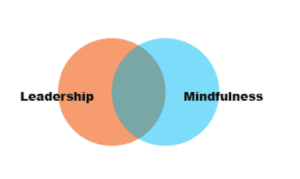Guest post by Gareth Wilson.
The challenges of modern leadership are growing and complex. The good news is that many leaders already have several of the key traits needed to overcome them – a desire for self-improvement and the will to succeed. However, will and motivation cannot be truly effective without direction. That’s why I’d like to discuss mindfulness; what it is, what it does, and how it can be applied by leaders to help them achieve results.
What is mindfulness?
 Mindfulness is best categorized alongside exercise or healthy eating: not as an esoteric fad, but as something that can be incorporated into your daily routine that will deliver multiple results across a number of fields, at home and in the workplace.
Mindfulness is best categorized alongside exercise or healthy eating: not as an esoteric fad, but as something that can be incorporated into your daily routine that will deliver multiple results across a number of fields, at home and in the workplace.
Both a practice and a state of mind – mindfulness is the journey and the destination. Being mindful is to have awareness, presence, focus and attention.
Therefore the question is not: ‘What can mindfulness do for leaders?’, but what tangible benefits can derive from having better attention to detail; increased presence; more focus and an enhanced awareness of the events taking place around you?
Neuroscience
Juliet Adams, the co-author of Mindful Leadership for Dummies, writes that a ‘core component of mindfulness is learning to observe your own unique patterns of thought and behavior. This allows you to take control and become a wiser, more considered leader.’ Juliet highlights the science behind mindfulness, particularly in the emerging and powerful field of neuroscience where numerous studies have already demonstrated the wellbeing benefits of mindfulness such as stress reduction, increased resilience, and greater energy levels.
 However, where mindfulness comes into its own is in the development of neuro-plasticity – ‘the brain’s ability to change and adapt as a result of experience’. In other words, mindfulness can make you a more agile leader – which can be a valuable tool in a globalized economy with multiple transformative events potentially impacting upon your organization.
However, where mindfulness comes into its own is in the development of neuro-plasticity – ‘the brain’s ability to change and adapt as a result of experience’. In other words, mindfulness can make you a more agile leader – which can be a valuable tool in a globalized economy with multiple transformative events potentially impacting upon your organization.
In the workplace
Parham Vasaiely, Engineering Manager at Jaguar Land Rover, who has been taking the lead in introducing mindfulness into the business believes that ‘more than ever organizations are faced with complex social and economic environments when operating in a highly competitive global marketplace. These challenges demand leaders to operate more efficiently and to streamline their operations to respond quicker to changing demands. The workforce is faced with additional pressures too, which may have an impact on their wellbeing and performance. Mindfulness as a principle, supported by a set of techniques and tools, is a powerful and sustainable approach to addressing these pressures in the workplace.’
One of Juliet’s mantras is that you should ‘give yourself permission to take time out to be mindful’. Start off small, see if you gain any benefits and work your way from there: try a few gentle exercises before attempting the Three Peak Challenge!
Five exercises for the workday
 Here are a few things to get you going from Chris Tamdjidi, the co-founder and Director of the Kalapa Academy.
Here are a few things to get you going from Chris Tamdjidi, the co-founder and Director of the Kalapa Academy.
Arrive
Upon arriving at your workplace, before you begin ANYTHING, take just 3 minutes to really arrive. Sitting in your chair, take a good, upright posture, place your hands softly on your thighs, both feet on the ground. Feel your breath. Without changing anything, observes how the breath flows in – and out – and in again. Sit just for 3 minutes like this, with your awareness on the breath. When thoughts arise, simply notice this and in your mind say ‘thinking’ and gently return again to the breath. At the end of the 3 minutes, take your time to stretch a bit, notice how you feel, what has changed, and from here, begin your workday.
Begin to notice how much time do you spend on e-Mails a day? How many do you get? How often do you check your emails? Email is a crucial part of value generation – typically we need to spend 25% of our workday doing emails. Do you plan time for this? How often do you allow emails to interrupt you? Try to focus on 3 times per day, really taking the time to answer them well, and then not looking into your box. If that is not possible then agree on 5 times per day – but try to reduce the fragmentation and the poor attention that causes more work for everyone.
Really listen
As a leader, the quality of your attention is crucial for the culture of an organization. When people ask for your attention try to listen really deeply, mindfully, without judgment. Don’t interrupt, don’t edit, but do provide boundaries: time, and focus. Begin to establish this as a practice with your team – explaining to them the benefits of really listening, and noticing how often we do not listen. Do this in team meetings and see what the outcome is when everyone really listens.
On the go
Going from one meeting to another, on the way to the airport, or during lunch: take advantage of these transitions. Go a little slower than usual and focus your attention on your walking: how your feet press and roll off the ground as you move. Be conscious and aware of walking. Then before going into the meeting, pause and formulate a goal for the meeting.
End the day
In order to really leave the day behind you, you must make a conscious transition. Do not rush away from your desk, but take 5 minutes of your time to wrap-up your day internally – what is unfinished, what is pressing, what was successful, what less so?
Chris Tamdjidi, Juliet Adams, and Parham Vasaiely all spoke at Mind and Matter Leaders, the UK’s first mindful leadership conference, taking place in London on October 14th, 2016.

3 Responses
Nice! I love the practical tips at the end. Definitely something to work on.
Greetings from Brazil!
Thank you for sharing such interesting subject.
I believe such approach can really help us to improve our life and professional skills and performance.
A nice list of things to do in order to achieve some mindfulness at work. Thanks.
I especially liked “listening.” Take that category and practice it for a full day: listen to conversations, of course. And also focus on the sounds your keyboard is making as you type, the sound of your feet on pavement, the sound your chair makes as it pushes away from your desk, the sound of a toilet flushing, and the sound of water as you wash your hands. There are sounds all around. Listen to them and you’ll find paying attention to other tasks becomes easier.